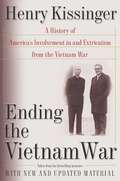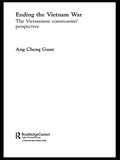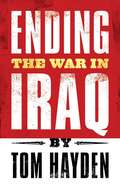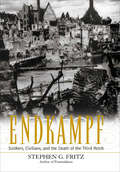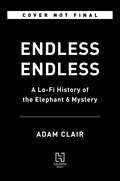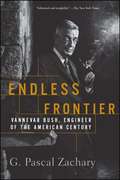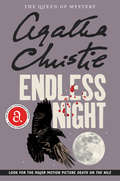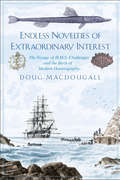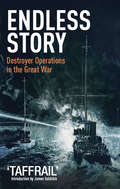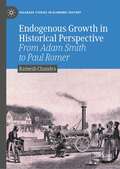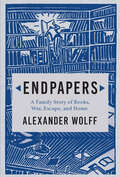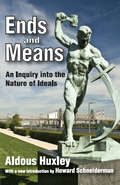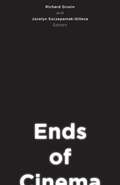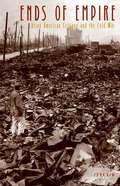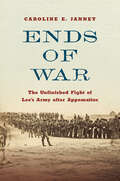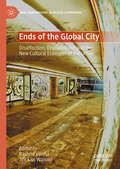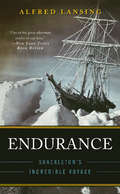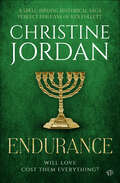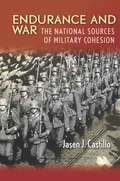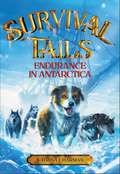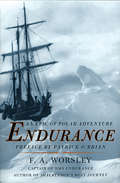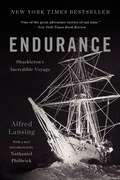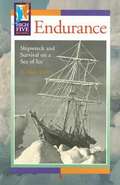- Table View
- List View
Ending the Vietnam War: A History of America's Involvement in and Extrication from the Vietnam War
by Henry KissingerNow, for the first time, Kissinger gives us in a single volume an in-depth, inside view of the Vietnam War, personally collected, annotated, revised, and updated from his bestselling memoirs and his book Diplomacy.Many other authors have written about what they thought happened—or thought should have happened—in Vietnam, but it was Henry Kissinger who was there at the epicenter, involved in every decision from the long, frustrating negotiations with the North Vietnamese delegation to America's eventual extrication from the war. Here, Kissinger writes with firm, precise knowledge, supported by meticulous documentation that includes his own memoranda to and replies from President Nixon. He tells about the tragedy of Cambodia, the collateral negotiations with the Soviet Union and the People's Republic of China, the disagreements within the Nixon and Ford administrations, the details of all negotiations in which he was involved, the domestic unrest and protest in the States, and the day-to-day military to diplomatic realities of the war as it reached the White House. As compelling and exciting as Barbara Tuchman's The Guns of August, Ending the Vietnam War also reveals insights about the bigger-than-life personalities—Johnson, Nixon, de Gaulle, Ho Chi Minh, Brezhnev—who were caught up in a war that forever changed international relations. This is history on a grand scale, and a book of overwhelming importance to the public record.
Ending the Vietnam War: The Vietnamese Communists' Perspective (Routledge Studies in the Modern History of Asia #Vol. 14)
by Cheng Guan AngExisting studies of the Vietnam War have been written mostly from an American perspective, using western sources, and viewing the conflict through western eyes. This book, based on extensive original research, including Vietnamese, Chinese and former Soviet sources, tells the story of the war from the Tet offensive in 1968 up to the reunification of Vietnam in April 1975. Overall, it provides an important corrective to the predominantly US-centric narratives of the war by placing the Vietnamese communists centre-stage in the story. It is a sequel to the author's RoutledgeCurzon book The Vietnam War From the Other Side, which covers the period 1962-68.
Ending the War in Iraq
by Tom HaydenTom Hayden, a more thoughtful well-informed batter organized seasoned Political Leader renders a pragmatic tale of how we got into Iraq, and the how's and why's we can and should come to a consensus on getting out.
Endkampf: Soldiers, Civilians, and the Death of the Third Reich
by Stephen G. Fritz&“This thoroughly researched and superbly written study&” examines the final days of WWII combat within Germany during the occupation of Franconia (WWII History). At the end of World War II, Gen. Dwight D. Eisenhower turned US forces toward the Franconian region of Germany, ordering them to cut off and destroy German units before they could escape into the Alps. Opposing this advance were German forces headed by SS-Gruppenführer Max Simon, a committed National Socialist who advocated merciless resistance. Caught in the middle were the people of Franconia. Historians have largely overlooked this period of violence and terror, but it provides insight into the chaotic nature of life while the Nazi regime was crumbling. Neither German civilians nor foreign refugees acted simply as passive victims caught between two fronts. Throughout the region people pressured local authorities to end the senseless resistance. Others sought revenge for their tribulations in the &“liberation&” that followed. Stephen G. Fritz examines the predicament and perspective of American GI's, German soldiers and officials, and the civilian population. Endkampf is a gripping portrait of the collapse of a society and how it affected those involved, whether they were soldiers or civilians, victors or vanquished, perpetrators or victims.
Endless Endless: A Lo-Fi History of the Elephant 6 Mystery
by Adam ClairAn inspiring, revelatory exploration of the genesis and impact of the fabled Elephant 6 collective and the baffling exodus of its larger-than-life luminary, Neutral Milk Hotel frontman Jeff Mangum Years after its release, Neutral Milk Hotel&’s In the Aeroplane Over the Sea remains one of the most beloved and best-selling albums in all of indie music, hailed as a classic so influential as to be almost synonymous with the ongoing vinyl revival. But despite its outsized impact, a question looms even larger: why did frontman Jeff Mangum, just as the record propelled him to the brink of music superstardom, choose instead to disappear entirely? The mystery has perplexed listeners for decades—until now. In barely two years, Neutral Milk Hotel rose from house show obscurity in Athens, Georgia, to widespread hype and critical acclaim, selling out rock clubs across the country and gracing the tops of numerous year-end best-of lists. But just as his band was reaching the escape velocity necessary to ascend from indie rock success to mainstream superstar, Mangum hit the eject button. After the 1998 release of Aeroplane and a worldwide tour to support it, Mangum stopped playing shows, releasing new music, or even doing interviews. He never explained why, not even to his friends or colleagues, but thanks to both the strength of Aeroplane and his vexing decision to walk away from rock stardom, Neutral Milk Hotel&’s impact only grew from there. In Endless Endless, Adam Clair finds the answer to indie rock&’s biggest mystery, which turns out to be much more complicated and fascinating than the myths or popular speculation would have you believe. To understand Mangum and Neutral Milk Hotel and Aeroplane requires a deep dive into the unconventional inner workings of the mercurial collective from which they emerged, the legendary Elephant 6 Recording Company. Endless Endless details the rise and fall of this radical music scene, the lives and relationships of the artists involved and the colossal influence that still radiates from it, centered around the collective&’s accidental figurehead, one of the most idolized and misunderstood artists in the world, presenting Mangum and his collaborators in vividly human detail and shining a light into the secret world of these extraordinary and aggressively bizarre artists. Endless Endless offers unprecedented access to this notoriously mysterious collective, featuring more than 100 new interviews and dozens of forgotten old ones, along with never-before-seen photos, answering questions that have persisted for decades while also provoking new ones. In this deeply researched account, Endless Endless examines not just how the Elephant 6 came to be so much more than the sum of its parts, but how community can foster art—and how art can build community.
Endless Frontier: Vannevar Bush, Engineer of the American Century
by G. Pascal ZacharyA prodigiously researched biography of Vannevar Bush, one of America’s most awe-inspiring polymaths and the secret force behind the biggest technological breakthroughs of the twentieth century.As the inventor and public entrepreneur who launched the Manhattan Project, helped to create the military-industrial complex, conceived a permanent system of government support for science and engineering, and anticipated both the personal computer and the Internet, Vannevar Bush is the twentieth century’s Ben Franklin. In this engaging look at one of America’s most awe-inspiring polymaths, writer G. Pascal Zachary brings to life an American original—a man of his time, ours, and beyond. Zachary details how Bush cofounded Raytheon and helped build one of the most powerful early computers in the world at MIT. During World War II, he served as Roosevelt’s adviser and chief contact on all matters of military technology, including the atomic bomb. He launched the Manhattan Project and oversaw a collection of 6,000 civilian scientists who designed scores of new weapons. After the war, his attention turned to the future. He wrote essays that anticipated the rise of the Internet and boldly equated national security with research strength, outlining a system of permanent federal funding for university research that endures to this day. However, Bush’s hopeful vision of science and technology was leavened by an understanding of the darker possibilities. While cheering after witnessing the Trinity atomic test, he warned against the perils of a nuclear arms race. He led a secret appeal to convince President Truman not to test the Hydrogen Bomb and campaigned against the Red Scare. Elegantly and expertly relayed by Zachary, Vannevar’s story is a grand tour of the digital leviathan we know as the modern American life.
Endless Intervals: Cinema, Psychology, and Semiotechnics around 1900
by Jeffrey West KirkwoodRevealing cinema&’s place in the coevolution of media technology and the humanCinema did not die with the digital, it gave rise to it. According to Jeffrey West Kirkwood, the notion that digital technologies replaced analog obscures how the earliest cinema laid the technological and philosophical groundwork for the digital world. In Endless Intervals, he introduces a theory of semiotechnics that explains how discrete intervals of machines came to represent something like a mind—and why they were feared for their challenge to the uniqueness of human intelligence.Examining histories of early cinematic machines, Kirkwood locates the foundations for a scientific vision of the psyche as well as the information age. He theorizes an epochal shift in the understanding of mechanical stops, breaks, and pauses that demonstrates how cinema engineered an entirely new model of the psyche—a model that was at once mechanical and semiotic, discrete and continuous, physiological and psychological, analog and digital.Recovering largely forgotten and untranslated texts, Endless Intervals makes the case that cinema, rather than being a technology assaulting the psyche, is in fact the technology that produced the modern psyche. Kirkwood considers the ways machines can create meaning, offering a fascinating theory of how the discontinuous intervals of soulless mechanisms ultimately produced a rich continuous experience of inner life.
Endless Night (The\agatha Christie Collection #Vol. 68)
by Agatha ChristieOne of Agatha Christie’s personal favorites, Endless Night is a critically acclaimed classic crime thriller from the beloved queen of mystery.When penniless Michael Rogers discovers the beautiful house at Gypsy’s Acre and then meets the heiress Ellie, it seems that all his dreams have come true at once. But he ignores an old woman’s warning of an ancient curse, and evil begins to stir in paradise. As Michael soon learns: Gypsy’s Acre is the place where fatal “accidents” happen.
Endless Novelties of Extraordinary Interest: The Voyage of H.M.S. Challenger and the Birth of Modern Oceanography
by Doug MacdougallA gripping tale of exploration aboard H.M.S. Challenger, an expedition that laid the foundations for modern oceanography From late 1872 to 1876, H.M.S. Challenger explored the world’s oceans. Conducting deep sea soundings, dredging the ocean floor, recording temperatures, observing weather, and collecting biological samples, the expedition laid the foundations for modern oceanography. Following the ship’s naturalists and their discoveries, earth scientist Doug Macdougall engagingly tells a story of Victorian-era adventure and ties these early explorations to the growth of modern scientific fields. In this lively story of discovery, hardship, and humor, Macdougall examines the work of the expedition’s scientists, especially the naturalist Henry Moseley, who rigorously categorized the flora and fauna of the islands the ship visited, and the legacy of John Murray, considered the father of modern oceanography. Macdougall explores not just the expedition itself but also the iconic place that H.M.S. Challenger has achieved in the annals of ocean exploration and science.
Endless Story: Destroyer Operations in the Great War
by James GoldrickAlthough it was first published in 1931, Endless Story remains the only comprehensive account of the services of the Navys small craft destroyers, torpedo boats and patrol vessels during the First World War, and moreover the only one written by an officer personally involved. Even if Dorling did not take part in all the actions he describes, he knew the men who did, and gleaned much of his information from personal contact. As a result the book has both authenticity and authority, but is composed with the all verve of the popular novelist that Taffrail was to become. It was a bestseller in its day, and now enjoys the status of a classic.
Endogenous Growth in Historical Perspective: From Adam Smith to Paul Romer (Palgrave Studies in Economic History)
by Ramesh ChandraIn recent decades, new endogenous growth theory has become popular but the ideas are not new. They go back at least as far as Adam Smith, and the subsequent contributions made notably by Alfred Marshall and Allyn Young. This book critically discusses and provides an historical perspective to the entire spectrum of endogenous growth theories starting with Adam Smith and ending with Paul Romer. It fills an important gap in the literature. While contributions of individual authors are readily available, there is no comprehensive study on the subject covering such a vast ground, critically discussing these authors in a comprehensive framework. It collates all the arguments and economic viewpoints in one collection, providing both the seasoned economist and a graduate economist with a critical comparison of origin, mechanisms, conclusions, and policy implications of these models.
Endpapers: A Family Story of Books, War, Escape, and Home
by Alexander Wolff“A powerfully told story of family, honor, love, and truth . . . the beautiful and haunting stories told in this book transcend policy and politics.” —Beto O’RourkeA literary gem researched over a year the author spent living in Berlin, Endpapers excavates the extraordinary histories of the author’s grandfather and father: the renowned publisher Kurt Wolff, dubbed “perhaps the twentieth century’s most discriminating publisher” by the New York Times Book Review, and his son Niko, who fought in the Wehrmacht during World War II before coming to America.Born in Bonn into a highly cultured German-Jewish family, Kurt became a publisher at twenty-three, setting up his own firm and publishing Franz Kafka, Joseph Roth, Karl Kraus, and many other authors whose books would soon be burned by the Nazis. After fleeing Germany in 1933, Kurt and his second wife, Helen, founded Pantheon Books in a small Greenwich Village apartment. Pantheon would soon take its own place in literary history with the publication of Nobel laureate Boris Pasternak’s novel Doctor Zhivago, and as the conduit that brought major European works to the States. But Kurt’s taciturn son Niko, offspring of his first marriage to Elisabeth Merck, was left behind in Germany, where despite his Jewish heritage he served the Nazis on two fronts. As Alexander Wolff visits dusty archives and meets distant relatives, he discovers secrets that never made it to the land of fresh starts, including the connection between Hitler and the family pharmaceutical firm E. Merck.With surprising revelations from never-before-published family letters, diaries, and photographs, Endpapers is a moving and intimate family story, weaving a literary tapestry of the perils, triumphs, and secrets of history and exile.
Ends and Means: An Inquiry into the Nature of Ideals
by Aldous HuxleyContemporary intellectuals still struggle over the relationship of ends to means, especially in political discourse. Pacifism is still an important topic today, as terrorism and dictatorial states abound. Many will find solace in Ends and Means, while others will find the book only a case study of the relationship of ethics to politics.Aldous Huxley examines common issues in a unique fashion. How can the regression in charity through which we are living, and for which each one of us is in some measure responsible, be halted and reversed? How can existing society be transformed into the ideal society described by the prophets? How can the average sensual man and the exceptional (and more dangerous) ambitious man be transformed into a non-attached being, one who can create a society significantly better than our own?Huxley discusses the relationship between the theories and the practices of reformers and the nature of the universe. He argues that our beliefs about the ultimate nature of reality help us formulate conceptions of right and wrong, not only in our private life, but also in the sphere of politics and economics. Far from being irrelevant, our philosophical beliefs are the final determining factor in our actions. This provocative classic volume, now available in paperback, will continue to stimulate discussion and thought.
Ends of Cinema (21st Century Studies)
by Richard Grusin Jocelyn Szczepaniak-GilleceAt the dawn of the digital era in the final decades of the twentieth century, film and media studies scholars grappled with the prospective end of what was deemed cinema: analog celluloid production, darkened public movie theaters, festival culture. The notion of the &“end of cinema&” had already been broached repeatedly over the course of the twentieth century—from the introduction of sound and color to the advent of television and video—and in Ends of Cinema, contributors reinvigorate this debate to contemplate the ends, as well as directions and new beginnings, of cinema in the twenty-first century.In this volume, scholars at the forefront of film and media studies interrogate multiple potential &“ends&” of cinema: its goals and spaces, its relationship to postcinema, its racial dynamics and environmental implications, and its theoretical and historical conclusions. Moving beyond the predictable question of digital versus analog, the scholars gathered here rely on critical theory and historical research to consider cinema alongside its media companions: television, the gallery space, digital media, and theatrical environments. Ends of Cinema underscores the shared project of film and media studies to open up what seems closed off, and to continually reinvent approaches that seem unresponsive. Contributors: Caetlin Benson-Allott, Georgetown U; James Leo Cahill, U of Toronto; Francesco Casetti, Yale U; Mary Ann Doane, U of California Berkeley; André Gaudreault, U de Montréal; Michael Boyce Gillespie, City College of New York; Mark Paul Meyer, EYE Filmmuseum; Jennifer Lynn Peterson, Woodbury U, Los Angeles; Amy Villarejo, Cornell U.
Ends of Empire: Asian American Critique and the Cold War (Critical American Studies)
by Jodi KimEnds of Empire examines Asian American cultural production and its challenge to the dominant understanding of American imperialism, Cold War dynamics, and race and gender formation. Jodi Kim demonstrates the degree to which Asian American literature and film critique the record of U.S. imperial violence in Asia and provides a glimpse into the imperial and gendered racial logic of the Cold War. She unfolds this particularly entangled and enduring episode in the history of U.S. global hegemony—one that, contrary to leading interpretations of the Cold War as a simple bipolar rivalry, was significantly triangulated in Asia. <P><P>The Asian American works analyzed here constitute a crucial body of what Kim reveals as transnational “Cold War compositions,” which are at once a geopolitical structuring, an ideological writing, and a cultural imagining. Arguing that these works reframe the U.S. Cold War as a project of gendered racial formation and imperialism as well as a production of knowledge, Ends of Empire offers an interdisciplinary investigation into the transnational dimensions of Asian America and its critical relationship to Cold War history.
Ends of War: The Unfinished Fight of Lee's Army after Appomattox
by Caroline E. JanneyThe Army of Northern Virginia's chaotic dispersal began even before Lee and Grant met at Appomattox Court House. As the Confederates had pushed west at a relentless pace for nearly a week, thousands of wounded and exhausted men fell out of the ranks. When word spread that Lee planned to surrender, most remaining troops stacked their arms and accepted paroles allowing them to return home, even as they lamented the loss of their country and cause. But others broke south and west, hoping to continue the fight. Fearing a guerrilla war, Grant extended the generous Appomattox terms to every rebel who would surrender himself. Provost marshals fanned out across Virginia and beyond, seeking nearly 18,000 of Lee's men who had yet to surrender. But the shock of Lincoln's assassination led Northern authorities to see threats of new rebellion in every rail depot and harbor where Confederates gathered for transport, even among those already paroled. While Federal troops struggled to keep order and sustain a fragile peace, their newly surrendered adversaries seethed with anger and confusion at the sight of Union troops occupying their towns and former slaves celebrating freedom. In this dramatic new history of the weeks and months after Appomattox, Caroline E. Janney reveals that Lee's surrender was less an ending than the start of an interregnum marked by military and political uncertainty, legal and logistical confusion, and continued outbursts of violence. Janney takes readers from the deliberations of government and military authorities to the ground-level experiences of common soldiers. Ultimately, what unfolds is the messy birth narrative of the Lost Cause, laying the groundwork for the defiant resilience of rebellion in the years that followed.
Ends of the Global City: Disaffection, Displacement and the New Cultural Ecologies of the Urban (New Comparisons in World Literature)
by Jini Kim Watson Rashmi VarmaThis volume of essays explores how the global city is confronting new forms of crises and disruption. Examining cities in the Caribbean, North America, Africa, the Persian Gulf, Asia and Australia, the essays use literary and cultural analysis to examine the pasts, present and futures of the global city. Ranging from the period of high postcolonial development, industrialization and compacted modernization to present-day neoliberal urban planning, the collection considers arrivals and departures in the global city, offering new critical vocabularies to analyse ongoing processes of migration, economic immiseration, and environmental collapse.
Endurance
by Alfred LansingThe astonishing saga of polar explorer Ernest Shackleton's survival for over a year on the ice-bound Antarctic seas, as Time magazine put it, "defined heroism." Alfred Lansing's scrupulously researched and brilliantly narrated book -- with over 200,000 copies sold -- has long been acknowledged as the definitive account of the Endurance's fateful trip. To write their authoritative story, Lansing consulted with ten of the surviving members and gained access to diaries and personal accounts by eight others. The resulting book has all the immediacy of a first-hand account, expanded with maps and illustrations especially for this edition.
Endurance
by Alfred LansingThe astonishing saga of polar explorer Ernest Shackleton's survival for over a year on the ice-bound Antarctic seas, as Time magazine put it, defined heroism. Alfred Lansing's scrupulously researched and brilliantly narrated book -- with over 200,000 copies sold -- has long been acknowledged as the definitive account of the Endurance's fateful trip. To write their authoritative story, Lansing consulted with ten of the surviving members and gained access to diaries and personal accounts by eight others. The resulting book has all the immediacy of a first-hand account, expanded with maps and illustrations especially for this edition. <p> <b>New York Times Bestseller</b>
Endurance
by Christine JordanCan love prevail over prejudice in thirteenth-century England? The conclusion of the thrilling Hebraica trilogy by the author of Sacrifice and Massacre. When nine-year-old Henry, son of King John, is hastily crowned, the Jewish community is hopeful. But life isn&’t always kind . . . Against a backdrop of rising persecution, Mirabelle, a fiery Jewish woman, is determined to succeed with the help of her son, Bonanfaunt. Slowly, Mirabelle and her family climb the ranks and replace another family as leaders of their community. But as the years pass, life for a Jewish person remains extremely difficult. And when further draconian restrictions are imposed upon the livelihoods of the community, doubts are raised about whether they can survive in this increasingly hostile world. Will they be chased out of Gloucester for good, or can they endure the storm?
Endurance and War: The National Sources of Military Cohesion
by Jasen J. CastilloScholars and military practitioners alike have long sought to understand why some country's militaries fight hard when facing defeat while others collapse. In Endurance and War, Jasen Castillo presents a new unifying theory—cohesion theory—to explain why national militaries differ in their staying power. His argument builds on insights from the literatures on group solidarity in general and military effectiveness in particular, which argue that the stronger the ties binding together individuals in a group of any kind, the higher the degree of cohesion that a group will exhibit when taking collective action, including fighting in war. Specifically, he argues that two types of ties determine the cohesion, and therefore the resilience, of a nation's armed forces during war: the degree of control a regime holds over its citizens and the amount of autonomy the armed forces possess to focus on training for warfighting. Understanding why armed forces differ in their cohesion should help U.S. military planners better assess the military capabilities of potential adversaries, like Iran and North Korea. For scholars of international politics, cohesion theory can help provide insights into how countries create military power and how they win wars.
Endurance in Antarctica (Survival Tails #2)
by Katrina CharmanA group of sled dogs race to survive a perilous journey across Antarctica in the exhilarating second installment of Survival Tails, perfect for fans of the Ranger in Time and I Survived series! <P><P>Sled dog Samson wants nothing more than to be part of Ernest Shackleton's historic voyage to Antarctica. <P><P>He wants to feel the snow under his paws and the wind on his face as he races across the ice fields, and most of all he wants to help his humans find eternal glory as they chart the continent. His fellow sled dog, Bummer, just wants to get through the voyage in one piece. Why would he want to face down a dangerous, icy wasteland when he could stay inside his kennel, warm and safe? <P><P>When their ship, the Endurance, becomes trapped in sea ice, leaving the dogs and men with no way home, their journey becomes not about personal glory, but about survival. Samson, Bummer, and the other dogs will have to put aside their differences and band together to rescue their humans...and themselves. <P><P>With engaging nonfiction back matter that delves into the fascinating true story behind the book, Survival Tails: Endurance in Antarctica is sure to keep readers entertained as the second entry in this series of action-packed animal adventures.
Endurance: An Epic of Polar Adventure
by Frank Arthur WorsleyThe legendary tale of Ernest Shackleton's grueling Antarctic expedition, recounted in riveting first-person detail by the captain of HMS Endurance. "You seriously mean to tell me that the ship is doomed?" asked Frank Worsley, commander of the Endurance, stuck impassably in Antarctic ice packs. "What the ice gets," replied Sir Ernest Shackleton, the expedition's unflappable leader, "the ice keeps." It did not, however, get the ship's twenty-five crew members, all of whom survived an eight-hundred-mile voyage across sea, land, and ice to South Georgia, the nearest inhabited island. First published in 1931, Endurance tells the full story of that doomed 1914-16 expedition and incredible rescue, as well as relating Worsley's further adventures fighting U-boats in the Great War, sailing the equally treacherous waters of the Arctic, and making one final (and successful) assault on the South Pole with Shackleton. It is a tale of unrelenting high adventure and a tribute to one of the most inspiring and courageous leaders of men in the history of exploration.
Endurance: Shackleton's Incredible Voyage (Voyages Ser.)
by Alfred LansingBound for Antarctica, where polar explorer Ernest Shackleton planned to cross on foot the last uncharted continent, the Endurance set sail from England in August 1914. In January 1915, after battling its way for six weeks through a thousand miles of pack ice and only a day’s sail short of its destination, the Endurance became locked in an island of ice. For ten months the ice-moored Endurance drifted northwest before it was finally crushed. But for Shackleton and his crew of twenty-seven men, the ordeal had barely begun. It would end only after a miraculous journey through more than 850 miles of the South Atlantic’s heaviest seas to the closest outpost of civilization. In Endurance, the definitive account of Shackleton’s fateful trip, Alfred Lansing brilliantly narrates the harrowing voyage that has defined heroism for the last century.
Endurance: Shipwreck and Survival on a Sea of Ice
by Matt WhiteTells the story of the shipwreck of the Endurance in a sea of ice en route to Antarctica, and the amazing survival of all 28 members of the Imperial TransAntarctic Expedition, led by Sir Ernest Shackleton.
